x402 v2 version
The x402 v2 version, based on production deployment experience, represents a fundamental architectural change.
 JinseFinance
JinseFinance
Author: Bing Ventures Source: medium Translation: Shan Oppa, Golden Finance
< p style="text-align: left;">As the cryptocurrency market matures, decentralized derivatives exchanges such as GMXv2, Vertex Protocol, Hyperliquid, and Apex Protocol have gradually attracted attention. These platforms not only challenge GMX’s leadership, but also herald major changes in the decentralized finance (DeFi) space. This article explores the changes in the competitive landscape of the decentralized derivatives market after the GMX v2 upgrade and predicts the main trends in the future.
Source: Coingecko< /p>
The above table shows the average daily trading volume of spot and derivatives on decentralized exchanges (DEX) and centralized exchanges (CEX). DEX daily spot trading volume was $1.84 billion, with derivatives trading volume down slightly at $1.44 billion. For central exchanges, daily spot trading volume was $19.18 billion and daily derivatives trading volume was $64.78 billion.
CEX’s trading volume in both categories dwarfs that of DEX. This lead is most evident in derivatives trading. Despite the FTX incident and the subsequent unexpected decline of a series of centralized banks, it seems that CEX is the first choice for users after all. Additionally, derivatives trading volumes on central exchanges are much higher compared to spot trading volumes, underscoring the popularity of their derivatives products.
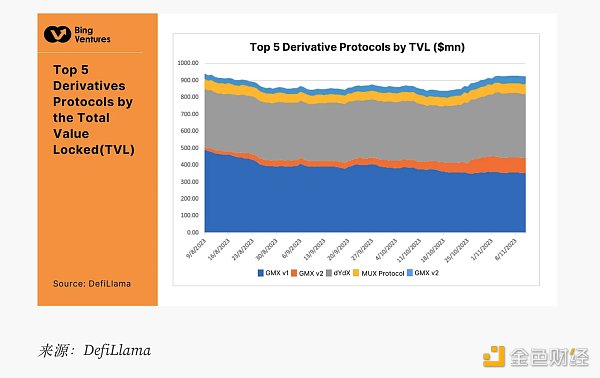
We analyze the evolution of the market since the official release of GMX v2. In the early days, the market was still dominated by GMX v1 and dYdX, with Mux Protocol and Apex Protocol lagging far behind in terms of total value locked (TVL), and GMX v2 only holding a small market share. As of November 5, 2023, in just four months, GMX v2 has tied or even surpassed Mux Protocol and Apex Protocol in terms of TVL (GMX v2: US$89.72 million; Mux Protocol: US$57.71 million; Apex Protocol: US$45.51 million). Additionally, as GMX v2 grows, the TVL of GMX v1 decreases. We believe this is due to users migrating from v1 to v2 as the latter fixes many of v1's flaws.

GMX v2’s daily trading volume has grown steadily since its launch, reflecting the market’s good response to the upgrade. An increase in TVL for GMX v2 relative to GMX v1 indicates a successful upgrade. In particular, transaction efficiency is improved and user fees are reduced. As a result, GMX v2 not only attracted new users, but also won over users of GMX v1. However, sustaining this growth and traction while maintaining platform stability and security will be challenging. This will determine the future of GMX v2.
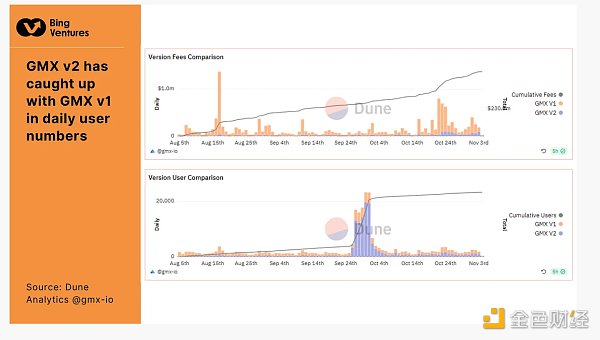
As can be seen from the above figure, the average daily number of users of GMX v2 has caught up with v1. For v2, however, the sources of user growth are more diverse, as it also attracts new users thanks to its successful marketing and user education efforts. Looking at fees, daily fee revenue for v1 is still higher than v2, reflecting their different fee structures. User growth reflects the market’s recognition of GMX v2’s improved user experience and transaction efficiency. How to convert new users into long-term users will be the primary issue for GMX v2. We believe GMX v2 should prioritize continuous improvements in user experience and community engagement to solidify its market position.
GMX v2’s fee structure has been adjusted to balance short and long positions and improve funding efficiency. The main adjustments include:
Reduced position opening/closing fees: the original 0.1% of opening and closing positions Closing fees have been reduced to 0.05% or 0.07%, depending on whether the trade increases long and short balances. If so, the lower fee applies. Otherwise, the fee is 0.07%.
Introduction of funding fees: In the balance of power between longs and shorts, the stronger party pays funds to the weaker party cost. This funding rate is not fixed, but is gradually adjusted over time based on the long-short ratio. For example, if the total number of long positions is greater than the amount of short positions, the funding rate paid by long positions to short positions will gradually increase until the difference between long and short positions is below a certain threshold or reaches the upper limit, at which time the funding rate will remain unchanged. vice versa. This adaptive interest rate mechanism helps increase arbitrage opportunities and attract arbitrage capital, thus promoting the balance of market forces.
All in all, we believe the primary challenge for GMX v2 is to sustain growth while ensuring the stability and growth of the platform. In the DeFi field, security incidents occur frequently. GMX v2 must ensure that such risks do not impact it. Another challenge is how to maintain an advantage in a highly competitive market, especially in the face of competition from new protocols. GMX v2 needs to continue to innovate to maintain the appeal of its products and services. Ultimately, the success of GMX v2 will depend on how well it balances growth with stability and innovation with security.

At the same time, we compared the monthly TVL changes of the top 15 derivatives protocols as of November 6, 2023. GMX and dYdX’s TVL growth looks tame compared to dark horses like Vertex Protocol, Hyperliquid, and Apex Protocol, which saw TVL growth of 63.22% and 30.69% respectively. TVL grew by % and 25.49% respectively. We’ll look at them one by one in the paragraphs below to find out the dynamics and narratives that drive their growth.
Vertex Protocol is a decentralized It is a comprehensive exchange with the characteristics of spot, perpetual and comprehensive currency markets. The protocol uniquely combines a centralized limit order book (CLOB) with an automated market maker (AMM) to enhance liquidity and transform the user trading experience.
The Vertex protocol is built on Arbitrum Layer 2 (L2), aiming to reduce Gas fees and combat Miner Extractable Value (MEV), promoting a decentralized space Efficient and cost-effective transactions. The protocol consists of three key pillars: an off-chain sequencer, an on-chain AMM, and a powerful on-chain risk engine. The order book and AMM work together to accumulate liquidity from API market makers and on-chain contributors. The risk engine guarantees fast liquidations, and dual liquidity sources enable traders to get better prices. The growing transaction volume on Vertex is a testament to the success of this unique model.
Vertex Protocol's cross margin system is friendly to both experienced and novice traders, significantly reducing margin requirements. For example, a Vertex trader with a long $ETH spot margined position and a short $ETH perpetual contract position may have lower cumulative margin requirements than a trader with the same positions in an isolated margin account. By introducing the concept of portfolio margining, the system enables traders to adjust the leverage of their positions across multiple positions to suit their individual risk appetite. If the long $ETH spot margin position declines in value, excess margin (e.g., unrealized profits) in the short $ETH perpetual position can be used to maintain the required margin levels and avoid liquidation of the long spot margin position. Vertex’s approach maximizes capital efficiency.

As shown in the figure above, the TVL and derivatives trading volume of Vertex Protocol have been established since It has been showing a steady upward trend since then.
Total Locked Value
Although Vertex provides an innovative trading experience, its TVL is still Clearly behind GMX. This is mainly because its money market functions are still very underdeveloped. Only supports lending and borrowing of 5 major assets including wBTC, wETC, and USDC. This limits its ability to capture more of the locked value. Additionally, its native token, VRTX, has not yet been launched as of this writing. This means users cannot stake VRTX to participate in the protocol.
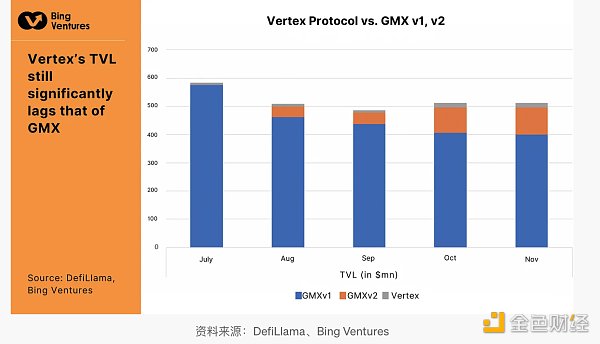
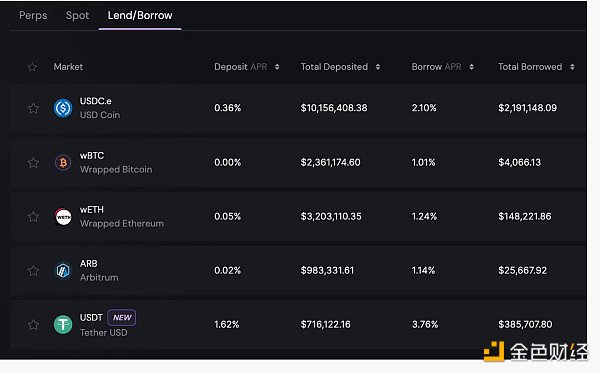
In the fiercely competitive DEX field, Vertex Protocol occupies the largest share of daily trading volume A large portion, ranging from 15% to 30%. This outstanding performance is outstanding even when compared with industry giants such as GMX, Gains, and Kwenta. Especially compared to GMX, Vertex has significantly higher trading volumes. As an emerging project, its transaction volume surpassed existing participants in such a short period of time, proving the appeal of its unique design to users.
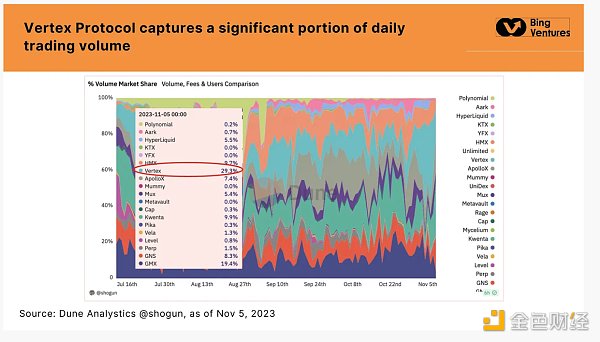
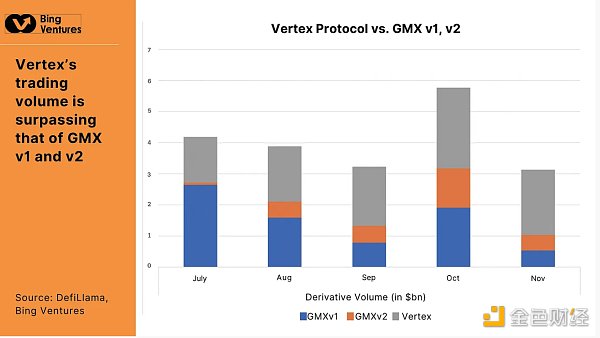


Fees of the Vertex protocol; Source: DefiLlama
GMX charges higher transaction fees than Vertex. Vertex Protocol has a zero-fee policy for market makers and extremely low fees for takers on major trading pairs (2 basis points for stablecoin pairs, 2-3 basis points for core markets, and 4 basis points for non-core markets) . By comparison, GMX v1 charged 0.1% for opening and closing a position (dropping to 0.05% or 0.07% in v2), with an additional fee of 0.2% to 0.8% if the trade involves an exchange. This fee structure advantage makes Vertex Protocol more attractive to users, although its lower fees may result in less significant revenue growth compared to trading volume growth.
We believe that Vertex Protocol has quickly established itself in the market by offering a very competitive low fee structure. This low-fee strategy attracts a large number of cost-conscious traders, especially in current market conditions where users are increasingly concerned about transaction costs. However, in the long term, this strategy may face profitability challenges, especially in maintaining high-quality services and platform operations.
Therefore, Vertex Protocol needs to explore additional value-added services and revenue models while continuing to attract users with low fees to ensure long-term sustainable development. While GMX’s daily transaction fees were previously significantly higher, they have recently dropped to around $100,000, roughly the same as Vertex Protocol. Combined with Vertex Protocol's steadily growing transaction volume, it is expected that its future revenue will have the potential to surpass GMX.
Hyperliquid is a Decentralized exchange for perpetual futures based on order book. It runs on the Hyperliquid chain, a Layer1 built on Tendermint. A key reason for Hyperliquid's rapid growth is that it exists on its own Layer1. This allows the Hyperliquid team to flexibly adjust gas fees, MEV, slippage, etc. to achieve the fastest and most efficient trading experience, so that the platform can support up to 20,000 orders per second.
Running on its own Layer1 also enables it to build a fully on-chain order book with complete transparency for every executed trade, which was demonstrated in the FTX event Very much needed in the aftermarket. Hyperliquid L1 makes it possible to build everything as on-chain, decentralized, trustless and permissionless as possible.

On Hyperliquid, Vaults provide liquidity for various trading strategies. They can be managed by individual traders or automated by market makers. Anyone can deposit into the vault to earn profits: DAO, protocol, institution or individual. In exchange, the vault owner receives 10% of the total profits.
Hyperliquid is also the first company to launch index perpetual contracts for Friend.tech. Initially this was based on TVL, but after it became clear that the TVL definition could be manipulated given the growing OI, it was changed to a static set of median prices for the top 20 subjects.

Like Vertex, the protocol’s TVL has been growing steadily since its launch , monthly derivatives trading volume reached approximately $1.5 billion after peaking at $8 billion. However, on average, Vertex Protocol still maintains a competitive advantage.

In terms of TVL, Hyperliquid still cannot compare with GMX. But compared to Vertex Protocol, which launched around the same time, Hyperliquid’s TVL lags only slightly, surpassing Vertex only in September. We believe its lower TVL is primarily due to the limitations of its staking and deposit capabilities. The project primarily locks funds through Vaults, where people deposit funds to receive a share of the profits. However, there are inherent risks in this method of copy trading, as profits and losses depend entirely on the trading skills of the vault owner. Therefore, these features provide insufficient assurance and are less attractive to investors.
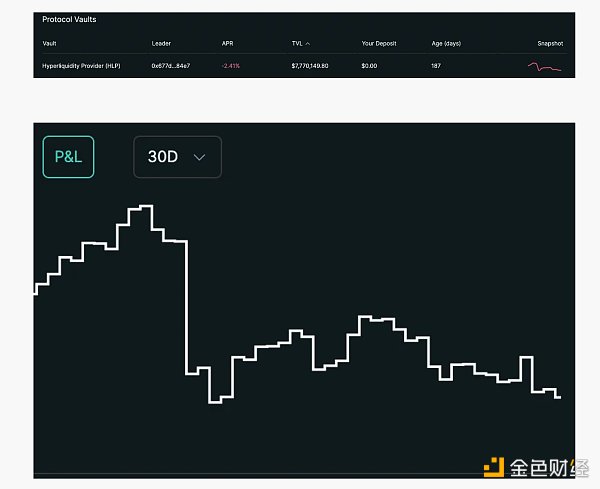
For example, the chart above shows the performance of the Hyperliquidity Provider (HLP), a protocol vault that makes and clears markets and collects a portion of transaction fees. We can see that the ROI is negative (-2.41%) and the profit-to-loss ratio continues to decrease, suggesting that users may have better options than depositing funds into Vaults.

Source: Dune Analytic @shogun, as of 2023 November 5
Hyperliquid holds about 6% of the market share. While not comparable to the Vertex protocol, it's still an impressive percentage for a new protocol. However, trading volumes have declined over the past month and have failed to maintain previous activity levels.
Hyperliquid’s fee structure is as follows:
Taker pays a fixed fee of 2.5 basis points, while market makers receive a 0.2 basis point rebate. The referrer receives 10% (0.25 basis points) of the referred user's recipient fee. The remaining fee income (approximately 2.05 basis points) accrues to insurance funds and HLP.
Unlike Vertex, where most of the fees are borne by the team or internal token holders, in Hyperliquid, the fees Distributed directly to the community: 40% to the insurance fund and 60% to the HLP.
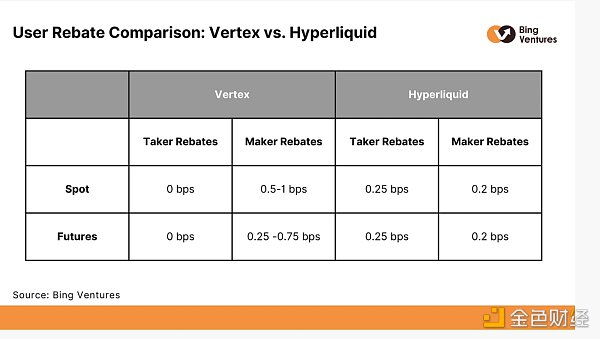
Hyperliquid's fee structure emphasizes giving back to the community. In contrast, Vertex Protocol offers zero fees for traders on major trading pairs and extremely low fees for takers. It uses a portion of transaction fees to support its vaults and liquidity providers. This disparity shows that Hyperliquid prefers to reward community members who directly support network operations and risk management.
Apex Pro is ApeX Protocol's latest product, built on StarkWare's layer 2 scalability engine StarkEx and running on an order book model, offers cross-margin perpetual contracts with a secure, efficient and user-friendly user experience. It is non-custodial, meaning a trader’s assets are entirely on-chain and can only be accessed by them using their private keys. Scaling the solution with zero-knowledge aggregation helps Apex improve transaction security and protect user privacy. It offers better trading fees compared to similar products like dYdX and GMX. Its staking and buyback reward mechanism and referral program also add to its appeal.
Key attractions of the ApeX staking program include:
There are no set terms or plans. Users can initiate and cancel staking at any time. The longer the staking period, the greater the returns.
Staking rewards take into account not only your pledged assets, but also your trading activity, and take into account additional earnings earned by trading (T2E ) activity score.

Apex Protocol’s TVL is also rising steadily . Its monthly derivatives trading volume has stabilized at around 1.7 billion, similar to the previous two protocols.

The TVL of Apex Protocol is significantly higher than the previous two. Its two yield-generating features, smart liquidity pools and Apex’s staking pool, are major contributors to its high TVL. Participation in the past has been very enthusiastic. The staking pool’s annual yield (APY) reaches 56.31%, while the smart liquidity pool also offers an attractive seven-day yield of 13.03% to users providing liquidity for their market-making strategies.


Compared to the other two protocols, Apex Protocol’s transaction volume growth trajectory is more Stable, indicating steady growth in user base and user engagement.

Apex's transaction fee growth trend is similar to Vertex. We believe that both Hyperliquid and Apex Protocol have established their market position by focusing on niche market segments and user groups, which allows them to more effectively serve the unique needs of these markets. Hyperliquid is known for its innovative fully on-chain order book, while Apex Protocol has gained recognition for its multi-chain support and efficient trade execution.
Based on available data, we compare all four protocols (GMX v2 , Vertex Protocol, Hyperliquid and ApeX Protocol) were scored on TVL, transaction volume, user growth, fee structure, user demographics, etc. to present their overall strength and risk tolerance. The image below shows some results.
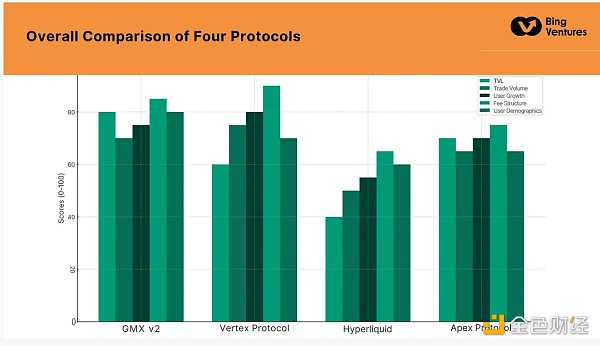
As the existing market leader, GMX v2 scores highly on multiple metrics, especially TVL and trading volume. It also performs well in terms of innovation capabilities, user experience, and community participation. However, regulatory compliance may be one area it could work on.
Vertex has a significant lead in the fee structure, which is its core competitiveness. Although the TVL and transaction volume are slightly lower compared to GMX v2, it has huge potential in terms of user growth and community engagement.
As a newer platform, Hyperliquid scores lower across all metrics, reflecting the challenges faced by emerging platforms. However, it has the potential to catch up in terms of security and user experience.
ApeX's scores are similar to Vertex's on several metrics. However, it slightly outperforms Vertex in terms of user experience and community engagement.
In summary, GMX is The status of the decentralized derivatives trading market is indeed being challenged by emerging protocols, especially Vertex Protocol. Leveraging on the strength of its fee structure, Vertex has started capturing more market share. This competitive landscape highlights that, even in this relatively mature market, innovative and user-friendly pricing strategies are still effective means of attracting users and increasing market share.
As far as TVL is concerned, emerging projects are still not comparable to GMX. This reflects that users remain cautious about depositing large amounts of assets into new platforms. The reason for this phenomenon may be that users lack trust in the new platform, product functions are incomplete, or market awareness is insufficient. Therefore, attracting user funds and increasing TVL will be a major challenge for these emerging protocols.
In addition to market competition, the development of these protocols will also be affected by factors such as market demand, technological progress, and regulatory environment. The following ten trends will shape the future of the decentralized derivatives market, and it is critical for existing and new players in the market to understand and adapt to these trends.
Market Reorganization
Due to changing user needs, the decentralized derivatives market is undergoing Undergoing major restructuring . People not only expect more functions, but also have increasingly higher requirements for user experience, financial efficiency, transparency, etc. This restructuring will result in existing market leaders being replaced by new players that are more flexible and innovative in meeting such user needs.
Acceleration of technological innovation
Technological innovation is the core of the development of new enterprises. We anticipate more innovative trading mechanisms, such as more efficient liquidity pools and improved risk management tools, to address the unique challenges of high volatility and unstable liquidity in the cryptocurrency market. Smart contracts will also be optimized in terms of security and the ability to implement more complex and efficient financial strategies. Continuous technological innovation is crucial for the platform to remain competitive.
Cross-chain transactions
As the cryptocurrency market matures, users increasingly require seamless transactions across different blockchains. seam deal. The development of cross-chain functions enhances asset liquidity and provides users with a wider range of trading opportunities. We predict that platforms that support multi-chain operations will gain competitive advantages due to their enhanced interoperability.
The requirements for regulatory adaptability continue to increase
With the development of the global regulatory landscape, the ability to maintain decentralization Platforms that are flexible and adaptable at the same time will have advantages. This means that platforms must not only pay attention to technological developments, but also pay close attention to international regulatory developments and adjust their operations to comply with legal requirements in different regions. Regulatory adaptability will become an important criterion for differentiating platforms in the future.
Fundamentally improve user experience
User experience will become a key factor in platform differentiation. As the decentralized finance user base grows, streamlining user interfaces and transaction processes and reducing technical barriers are critical to attracting a broad user base. This is not just a matter of interface design, but a rethinking of the entire transaction process. How to provide a user experience that is comparable to or better than that of centralized exchanges while maintaining decentralization should be a priority for all platforms.
Smart contract security
Smart contracts are the cornerstone of decentralized finance, and their security directly affects the reputation and assets of the platform Safety. Enhancing the security of smart contracts through methods such as stricter code audits and bug bounty programs is critical to building user trust and preventing the loss of funds.
Improving capital efficiency through innovative financial instruments
Decentralized platforms face significant challenges in capital efficiency. While traditional financial markets have a range of proven tools and strategies to improve capital efficiency, the crypto market still has a lot of room to grow. Future decentralized platforms will focus on innovative financial instruments and complex trading strategies, which will test market participants’ market understanding and financial innovation capabilities.
Decentralized governance
Decentralized governance is the core feature of blockchain technology. Effective community participation and transparent decision-making processes will increase platform credibility and user engagement. In order to achieve true decentralization, we expect that future platforms will place greater emphasis on the opinions of the community and make community participation an important part of the decision-making process.
Diversified synthetic assets and derivatives products
As the market matures, the demand for diversified investment tools will will continue to grow. Synthetic assets and various derivatives will be key to meeting this need. Future decentralized platforms will offer a wider range of derivatives, including options, futures and various complex financial products. These diversified products will appeal to a broader investor base and enhance market depth and liquidity.
New liquidity mining and incentive mechanism
In order to attract and retain users, new liquidity may be created and implemented Sex mining and incentives. These mechanisms should be able to attract user participation and maintain user activity over the long term. We expect a variety of new incentive mechanisms to emerge, including token rewards and diversified long-term incentives to cultivate user loyalty and increase engagement.
The x402 v2 version, based on production deployment experience, represents a fundamental architectural change.
 JinseFinance
JinseFinanceOn November 3, the Balancer V2 protocol and its fork projects were attacked on multiple chains, resulting in serious losses of over $120 million.
 JinseFinance
JinseFinanceAbracadabra lost $13 million in ETH due to a hack targeting GMX-linked pools. GMX denies its smart contracts were involved, raising questions about the vulnerability and each platform's role.
 Kikyo
KikyoIn-depth discussion of the core design, key functions and relevant audit points of the AAVE V2 protocol.
 JinseFinance
JinseFinance“The metaverse narrative [remains] the broadest of all narratives and is the superset of all other crypto narratives.”
 JinseFinance
JinseFinanceEight months after launching the first version of the Universal Data License (UDL), Arweave development incubator Forward Research has released UDL version 0.2.
 JinseFinance
JinseFinance JinseFinance
JinseFinanceGMX Crypto, the native cryptocurrency of Gmx.com, offers users various advantages within the platform. From transaction discounts to staking rewards and exclusive features, GMX Crypto enhances the user experience. Understand the key reasons for using GMX Crypto and explore its utilities within the GMX.com ecosystem. Additionally, learn about the distinctions between GMX and dYdX, two platforms with different focuses and features in the cryptocurrency space.
 Sanya
SanyaA founder of a DEX competitor to GMX said on Sept. 2 that an exploit could be pulled off on GMX which could leave GLP holders short. 16 days later, it happened.
 Others
Others Cointelegraph
Cointelegraph